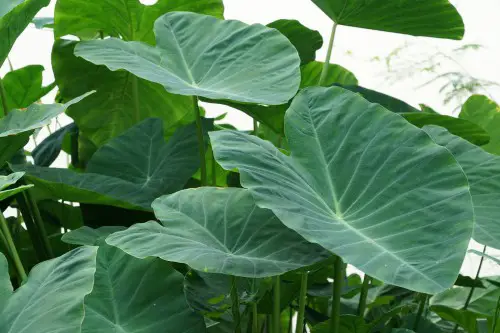Elephant ears (Colocasia esculenta) are a striking tropical plant that can add a unique touch to any garden. The foliage, which is long, broad, and green, is what draws people in rather than the blooms. They are easily recognizable by their large, heart-shaped leaves which can grow up to 3 feet in length! If you’re looking for a plant with a similar appearance, check out these 10 options.
- Alocasia
- Caladium
- Philodendron
- Dieffenbachia
- Spathiphyllum
- Syngonium
- Stephanotis
- Trelitzia
- Xanthosoma
Think you need a tropical climate to grow elephant ears? Think again! There are many plants that bear a striking resemblance to elephant ears that will thrive in a wide range of climates!
Plants Similar to Elephant Ears
Other look like plants:
1.Alocasia

There are a number of plants that are similar to elephant ears, including Alocasia. This plant is native to tropical regions of Asia, and it features large, glossy leaves that are similar in appearance to elephant ears. Like elephant ears, Alocasia can be grown in containers or in the ground, and it prefers moist, well-drained soil.
When grown in containers, Alocasia can reach a height of two feet, while plants grown in the ground may reach heights of four feet or more. In addition, Alocasia is a fast-growing plant, and it can quickly fill in an empty garden bed.
2. Caladium
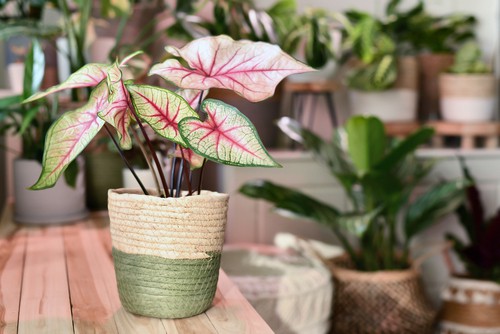
Caladium is a tropical plant that is native to South America. It is grown for its colourful leaves, which are often variegated with white, pink, or red. The leaves are heart-shaped and grow to a size of 10-30 cm (4-12 inches). Caladium is typically propagated from bulbs, and it can be grown in pots or in the ground.
The plant prefers moist, well-drained soil and partial shade. Caladium is susceptible to root rot, so it is important to water the plant carefully. Fertilize caladium monthly during the growing season with a balanced fertilizer. Pests that commonly affect caladium include aphids, scale insects, and whiteflies.
3. Philodendron

The Philodendron is a tropical plant that is native to the Americas. It is a member of the Araceae family, and it is closely related to the Monstera and Calla genera. The Philodendron has many different cultivars, but the most common one is the heartleaf Philodendron.
This plant is known for its heart-shaped leaves, which can range in color from green to burgundy. The Philodendron is a hardy plant that does well in low-light conditions.
It is an ideal houseplant for beginners, as it is very easy to care for. The Philodendron can be propagated by stem cuttings, and it will often produce aerial roots that can be used to support the plant.
4. Dieffenbachia
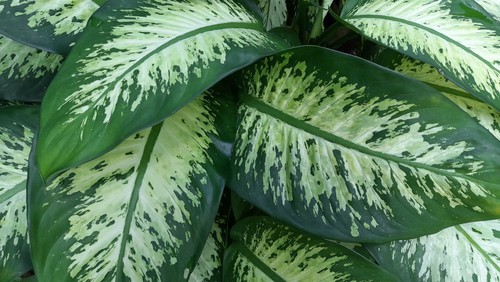
Dieffenbachia, also known as dumb cane, is a popular houseplant that is easy to care for and can thrive in a range of environments. The plant is native to tropical regions of the Americas, and its large, green leaves are often variegated with white or cream-colored patches.
Dieffenbachia is a slow-growing plant that can reach heights of up to six feet, but it is more commonly kept as a smaller potted plant.
The plant is poisonous if ingested, and its sap can cause skin irritation, so it is important to keep it out of reach of children and pets. Dieffenbachia prefers bright, indirect light but can tolerate low light levels. It should be watered when the top inch of soil is dry, and the plant will benefit from occasional misting.
5. Spathiphyllum
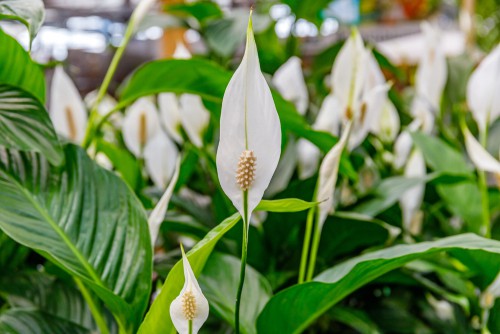
Spathiphyllum, more commonly known as the Peace Lily, is a beautiful and popular houseplant. Native to tropical regions of Asia and South America, the Peace Lily is known for its glossy green leaves and white flowers.
While it prefers humid conditions, the Peace Lily is relatively easy to care for and can tolerate low light levels.
In addition, the Peace Lily is known for its ability to purify air, making it a popular choice for indoor spaces. Because of its beauty and versatility, the Peace Lily is an excellent choice for both novice and experienced gardeners alike.
6. Syngonium
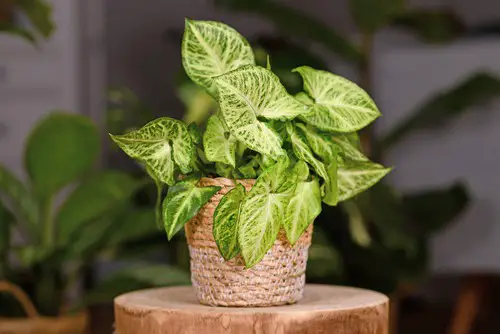
Native to the tropical rain forests of Central and South America, Syngonium is a genus of evergreen climbers. Also known as Arrowhead vines or Goosefoot plants, these vining plants are characterized by their arrow-shaped leaves.
The leaves may be solid green, variegated, or patterned with white or cream-colored markings.
Syngonium is a fast-growing plant that can reach up to 20 feet in length. Most varieties prefer moist, shady conditions and will not tolerate full sun. These plants are easy to care for and make an excellent addition to any indoor jungle.
7. Stephanotis
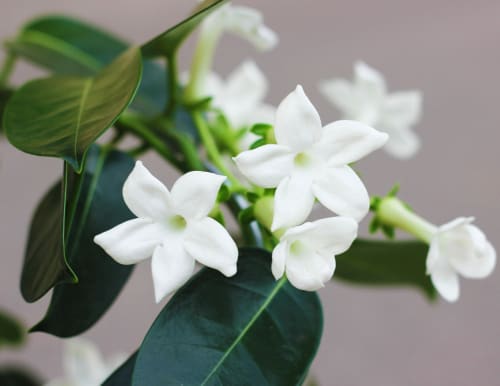
The Stephanotis is a beautiful waxy white flower that is often used in bridal bouquets andadds a touch of elegance to any special occasion.
Native to Madagascar, the Stephanotis prefers a warm, humid climate and lots of sun. This evergreen vine can grow up to 20 feet in length and produces small, fragrant flowers that bloom year-round.
The Stephanotis is a relatively easy plant to care for, but it does require regular watering and pruning to keep it healthy. Although it is not a particularly fast-growing plant, the Stephanotis can be an enjoyable addition to any home garden.
8. Trelitzia
The Trelitzia, more commonly known as the Bird of Paradise, is a stunning plant that is native to South Africa. The plant gets its name from its vibrant flowers which resemble the plumage of a tropical bird. The Trelitzia is a hardy plant that can grow up to six feet tall and four feet wide.
The leaves are large and tough, with a leathery texture. The flowers of the Trelitzia are truly unique, with long petals that range in color from orange to blue.
The blooms appear from mid-winter to early spring, and are followed by small fruits that are edible but not particularly flavorful. The Trelitzia is an easy plant to care for, and makes an excellent addition to any garden.
9. Xanthosoma
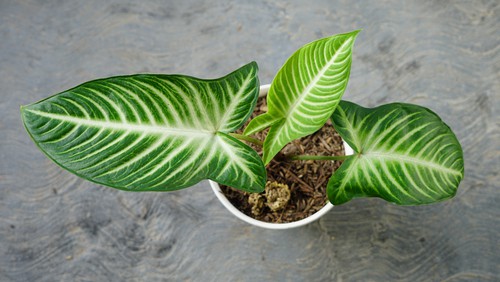
The Xanthosoma is a flowering plant that is native to tropical regions of South America. The plant has large, heart-shaped leaves and produce yellow, orange, or red flowers. The Xanthosoma is often used as an ornamental plant, due to its showy flowers and attractive foliage.
The plant can also be used for culinary purposes, as the leaves and stems are edible. The Xanthosoma is a resilieant plant that can tolerate a wide range of growing conditions.
However, the plant does require regular watering and prefers moist, well-drained soil. With proper care, the Xanthosoma will thrive and provide years of enjoyment.
Conclusion
Believe it or not, you don’t need a tropical climate to grow plants that look like elephant ears! In fact, there are many varieties of plants that bear a striking resemblance to elephant ears that will thrive in a wide range of climates.
One such plant is the alocasia, which is native to Asia and Australia. Alocasias come in a wide variety of colors and shapes, and some even have variegated leaves.
Another plant that resembles elephant ear is the caladium. Caladiums are native to South America and come in a wide variety of colors, including white, pink, red, and green.
They’re also very easy to care for and will thrive in both full sun and partial shade. So whether you live in a tropical climate or not, you can still enjoy the beauty of plants that look like elephant ears!
Frequently Asked Questions
Are there different types of elephant ear plants?
There are actually several different types of elephant ear plants, all of which are native to tropical regions of the world. The most popular variety is probably the giant elephant ear (Alocasia macrorrhiza), which can grow up to six feet tall and has heart-shaped leaves that can reach two feet in length.
Other popular varieties include the jeweled elephant ear (Colocasia esculenta), which has colorful leaves, and the Chinese elephant ear (Alocasia sinensis), which is smaller than the giant elephant ear and has thinner leaves.
Although they all have different appearance, all elephant ear plants are easy to care for and make great additions to any garden.
What is the difference between elephant ears and caladiums?
Both plants belong to the family Araceae and share many similarities. However, there are also several important differences between these two types of plants.
One major difference is that elephant ears are annuals, while caladiums are perennials.
This means that elephant ears only live for one growing season, while caladiums will come back year after year. Another difference is that elephant ears prefer full sun, while caladiums prefer partial shade.
This means that elephant ears will do best in a spot that gets a lot of direct sunlight, while caladiums will do better in a spot that is sheltered from the harsh afternoon sun. Finally, elephant ears can reach heights of six feet or more, while caladiums only grow to be about two feet tall.

Hey, I’m Lisa and I’ve been an avid gardener for over 30 years. I love writing, talking and living in the garden! Feel free to connect with me on my socials below

